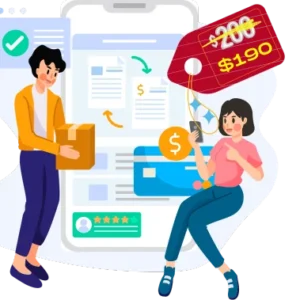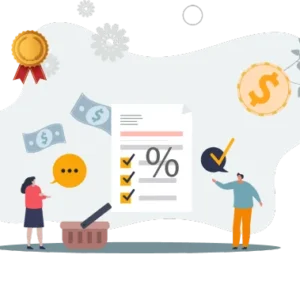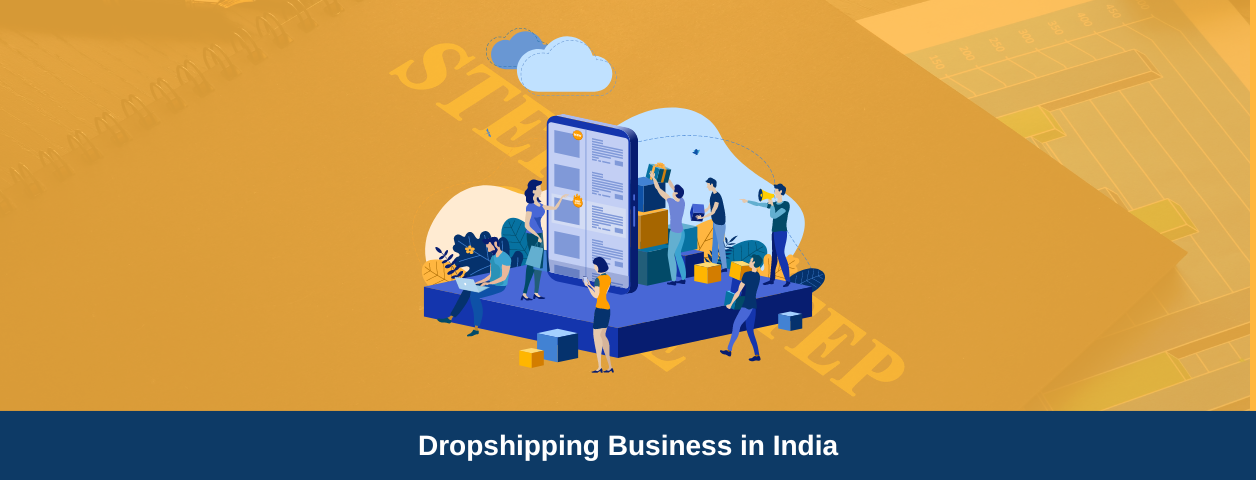One of the most important considerations you’ll make as you aim to increase sales in your print-on-demand businesses is how to price your products. Price is a major issue for customers; it is one of the primary aspects that consumers will evaluate when deciding whether to buy from you or one of your competitors.
It’s also worth mentioning that pricing is frequently one of the first things an internet consumer sees, even before reviewing the product’s full specifications. As a result, misjudging the price might turn off customers before they ever give your products significant thought.
Pricing a product correctly can make or break the success of any firm, large or small. Prices that are too high will discourage potential customers and lead them to the competition, but prices that are too low will throw a firm into the red.
Finding the best pricing requires a specific strategy tailored to your brand. Pricing a product or service must take into account costs as well as what the market will accept. The market, or customers, decide how much a product is worth and will only pay a certain amount.
Product pricing involves a variety of tactics, measures, and methodologies. Establishing a pricing point that would secure your market position, provide prospects for growth, and satisfy customers is critical.
Considerations before setting a price
Business owners must find an appropriate pricing plan. Product price is continually changing and is determined by various measurements and factors. Here are some things each entrepreneur should consider before deciding on product pricing.
The primary audiences
Understand your customer. What do they expect to get from the product or service? Do they choose the lowest alternative, or do they believe that price equals quality? How important is pricing in their purchasing decision?
Fixed expenses
Consider fixed expenses, if any exist. These are costs that remain constant regardless of the number of products sold. Merchants must price their products to offset these ongoing costs.
Market and competitor research
There is no purpose in charging much more than competitors unless there is a compelling reason to do so—pricing products based on existing price points for similar products that are already popular among the target demographic.
Costs that fluctuate
These are variable costs, as opposed to fixed expenses. Consider the expenses of product development and fulfilment. Merchants spend This amount of money to manufacture and sell their products.
Profitable Margin
This figure shows the portion of the sale converted into profit. Consider how much profit you want to make per sale. While there is no hard and fast rule, a reasonable profit margin is often between 10% and 30%.
Where should I sell?
Where will you advertise your things for sale? Online, at a physical store, or do you have other options? Because this decision will impact fixed expenses, it must be carefully considered.
How to price print-on-demand products?
Print-on-demand businesses can use various pricing techniques. Here are a few examples of how to price print-on-demand products.
1. Selecting specific pricing

Giving a super-specific pricing, such as $29.34, on the other hand, may assist buyers to consider the cost as more rational and acceptable. They may believe these more accurate figures imply a more thorough product value.
This method isn’t appropriate for every on-demand merchandise, but it has shown to be beneficial among print-on-demand businesses catering to “techies,” B2B customers, and other logic-driven consumers.
2. Get a loss leader strategy
The loss leader strategy has shown to be effective, not only among print-on-demand firms but also among businesses in general. In reality, retail behemoths like Amazon frequently employ the loss leader strategy.
What exactly does this procedure involve? Essentially, it’s all about attracting customers with a low-cost product but then growing revenues via well-targeted upselling and cross-selling.
For example, you may tempt people to your business with the promise of an extremely cheap tote bag but then compensate by offering bespoke T-shirts, caps, water bottles, or books to fill that tote bag.
The main idea is to make people believe you’re losing money on a certain item when, in reality, you’re only utilising that item to lure them to your store to look around.
3. Competitive pricing
Big chain retailers, convenience stores, and discount stores are the most likely to adopt competitive pricing. This method entails leveraging your competitors’ pricing to set the price of similar or identical products. Your competitors’ pricing structure serves as the foundation for developing your approach. Examine current trends and adjust prices accordingly.
4. Include costly products on the list
Here’s a print-on-demand pricing technique that uses some fundamental human psychology. When displaying a row of products, always place the most costly one on the left. Ideally, there will be a substantial gap between this product and others that follow it.
Simply said, starting with your most costly offering will make all of the things to the right look like steals!
The Benefits of Psychological Pricing
- Increases interest in your products
- Reduces the complexity of decision-making
- Provides a high rate of return on investment
5. Combine or sell bundle products

You’ve probably seen this strategy used by several online shops. For example, Product A costs $50 on its own, but Product B costs $65 on its own… However, the total cost is only $100 if you purchase both.
This is an excellent approach to cross-selling while giving your customers the impression that they are saving money. The major advantage of this strategy is that you may effectively set the desired rates while keeping customers satisfied. You may be able to persuade a conservative customer to spend more than usual since they will believe they are receiving a fantastic bargain.

6. Price skimming
Price skimming is a successful strategy for attracting trendsetters and influencers who want to be among the first to experience new products and services. This can increase consumer interest in products while making high-income customers loyal to your client base.
This happens all the time in the world of smartphones. Because new iPhone models are so fashionable when they first come out, they may cost about $1,000. They gradually grow more inexpensive to the general public, reaching people of all economic levels.
Another advantage of price skimming is that you will soon recover your manufacturing costs rather than experiencing an initial loss.
Price skimming doesn’t work as effectively for organisations that provide professional services, such as accounting firms and business consultants, because demand isn’t as strong. Subscription-based businesses, such as meal kit services and SaaS firms, may struggle to implement this model since high initial pricing discourages customers from making long-term recurrent payments.
On the other hand, price skimming can be effective in businesses that rely on trends, such as technology and fashion, or in industries with extremely high production costs, such as medicines.
7. Psychological pricing

No one wants to miss out on a good deal by setting the price just below a full number or offering hasty deals to urge buyers to buy more than they intended or convince them to buy soon.
8. Provide comparable things at slightly varying pricing
When browsing for on-demand merchandise, customers may face analysis paralysis. They won’t be able to choose between, say, ten different T-shirt alternatives for the same price. That usually implies they’ll just leave.
As a result, by providing some pricing distinction, you may assist your customers in selecting. Even little differences of a few pennies might have a significant impact.
9. Premium pricing

Premium pricing may convey a sense of luxury and reinforce the notion that you are a brand name while providing the impression that you have the highest quality things to offer. For example, when shopping for a t-shirt, many people pay an extra dollar or two to get Zara or Mango. However, all other alternatives operate precisely the same.
This pricing plan is only effective if you know high charges will not put your customers off, but it may swiftly boost your perceived worth.
10. Reasonable price
If you primarily target price-sensitive customers, you should pursue a competitive pricing approach instead. With this method, you will maintain your pricing lower than your competitors. To maintain their loyal customers, brands such as Best Buy and Target provide price match promises, even when rival retailers have deals.
This technique is frequently combined with economy pricing, in which businesses focus on keeping manufacturing costs as low as possible to give the best pricing feasible.
While a competitive price will not make your business seem unique, it will help you win over customers looking for a consistently reasonable offering.
Pros of Reasonable Pricing
- Simple to use and calculate
- Low risk puts you in line with the competition
- Evolve with the market, altering prices as necessary.
How to set the product price?
Now that you’ve considered the relevant factors, algorithms, and pricing tactics, it’s time to determine the price. And here’s how to accomplish it in five easy steps.
1. Determine your target market

Create client profiles based on age, gender, income, geography, and other characteristics. Investigate their hobbies, lifestyle, everyday difficulties, interests, and concerns, and position your product as the ultimate answer and point of interest.
2. Analyse the market and competitors
When entering a market with an existing product, it’s important to look into the pricing points for comparable or identical products supplied by competitors. Customers have definite expectations regarding similar products, and your prices should match them.
If they differ significantly from the competition’s offers, there should be a clear reason for this. What distinguishes your product? What makes it unique? Regarding eCommerce and online sales, always assume that buyers know the prices charged by rivals for the same or comparable product.
3. Calculate your costs

Variable costs vary based on the number of products manufactured. Variable costs include labour, raw materials, and other expenses. Keep in mind and calculate all of the costs associated with product delivery.
4. Choose a pricing strategy
Our pricing strategy guide comes in handy here. Consider the above-mentioned elements, expenses, and where you want to market while deciding on the best approach for your products. As a brand grows and expands within its business, it must modify its pricing methods.
Consider the pricing plans mentioned above and examine their use, applicability, and suitability for your firm. Consider your expenses, profit margins, competition, current market trends and demand, and, most crucially, your customers since they are the ones that drive your business and make profits.
5. Keep an eye on the results

You must stay current with market trends to build a dependable consumer base. Take note of competing prices, but most importantly, of the customers. Your product will have a healthy and profitable lifespan if you consistently fulfil their wants and sustain the essential cash flow.
Keep your prices smart
Every business needs excellent pricing tactics to maintain high-profit margins while minimising demand. You may capture and keep your customers loyal to your brand if you have a sound procedure for pricing each product or service. You’ll be confident in the prices you set for your products.
Pricing is rarely an easy or quick procedure. Pricing strategies and price points may work together to assist you in choosing the best price for your brand positioning, market, and perceived value to maximise profit margins while maintaining consumer loyalty.
Once you’ve determined your pricing for your next launch, it’s time to sell your product or service and get people to buy.
Read more
- Scaling Your Print-on-Demand Business on Shopify: Key Considerations
- Is Dropshipping a Profitable Business in India? 10 Key Factors to Consider
- The Power of Facebook Advertising for Your Print-on-Demand Business
- How To Optimize a Print-On-Demand eCommerce Website For Conversions? (Step-by-Step Guide to Double Your Conversion Rate)
- 10 Smart Pricing Strategies for Print-on-Demand Products
Frequently Asked Questions
What are Print-on-Demand (POD) products, and why are pricing strategies important?
Print-on-demand (or POD) is an order fulfillment method in which things are printed as soon as an order is placed, frequently without order minimums. POD allows you to develop bespoke designs for a wide range of products and sell them under your own brand.
Pricing strategies show how to value a brand, market, and customers. The industry and the specific goals of each organization determine the tactics. An effective pricing plan aids in developing customer trust and achieving a company’s financial objectives.
How do I determine the base cost of Print-on-Demand products for setting prices?
You must determine your product costs, including production, design, shipping, taxes, and other business expenses. Then, make sure to factor these costs into your sale pricing.
Should I offer discounts or promotions on my Print-on-Demand products?
You can offer discounts and promotional offers on your print-on-demand products. This will not only help increase your sales but also your brand awareness. However, proper planning and strategies are important before you run a sale.
How can I set competitive prices for my Print-on-Demand products?
Here’s how you can set competitive prices for your print-on-demand products:
Reduce the Competition – Determine comparable companies in the same market. Who else is selling the same or similar items?
Look into their product pricing strategies- Investigate their pricing methods and positioning to understand current trends.
Make a pricing map for your products– Compile the average selling price of all your competitors’ products. Use this as a guideline for ultimate product pricing.
Set Your Own Price- It’s now up to you. Choose a price greater, equal to, or lower than the prices supplied by competitors. Determine the product’s market fit and propose wise, competitive pricing.
Is it beneficial to offer a range of price points for my Print-on-Demand products?
As a seller, you can use pricing strategies that work well for your brand. Every business has a different pricing strategy, depending on your products and services. However, having multiple strategies at once could also harm your business if incorporated without proper planning.












